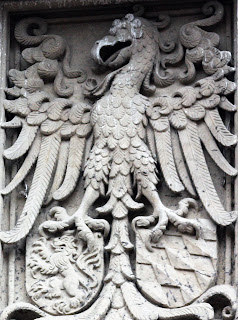You enter the castle complex through the typical defensible gates.that open out into multiple courtyards


Ultimately you end up in a larger open space
where you can inspect the semi restored walls and frontages.
If you have the telephoto you can also get close-up and personal with some of the statuary.
A necessary side stop is a quick look at the world's largest wine barrel
Then we were ushered through one of the facades and out to a terrace where we could look down at the old city and take some pictures.. Strangely this may be the only real function for the castle today. It whets your appetite to wander in the populated living old town below.
The river you see by the way is the Neckar, a smaller tributary of the Rhine.
We retraced our steps back through the castle courts and boarded our coach for a short trip back down the hill. We were dropped off near the market square with our guide.
The castle was now just an omnipresence looming above us.
Our ship, we were told, would now leapfrog ahead of us to Nierstein where we would rejoin it for lunch. This kind of time saving is another example of the clever way the river cruise operators can keep things moving and open up dock space at critical ports of call.
In the old city we examined the requisite squares lined with cafes

and of course did our religious duty in a church or two.
Monuments abound in these ancient city centers
but often it is the smaller items embedded in the cobbles that evoke the most emotion.
After our walk, we ambled back down to the river. We were admiring the old bridge over the Nekar when we noticed that folks seemed to be taking pictures of a baboon.
It didn't take me long to join the line to appear alongside one of the icons of the city.
Our coach picked us back up in time for lunch on board in Nierstein. While we ate we left for the short cruise to Mainz. The true home of Johannes Gutenberg awaited us.
See you in the next post.
























No comments:
Post a Comment